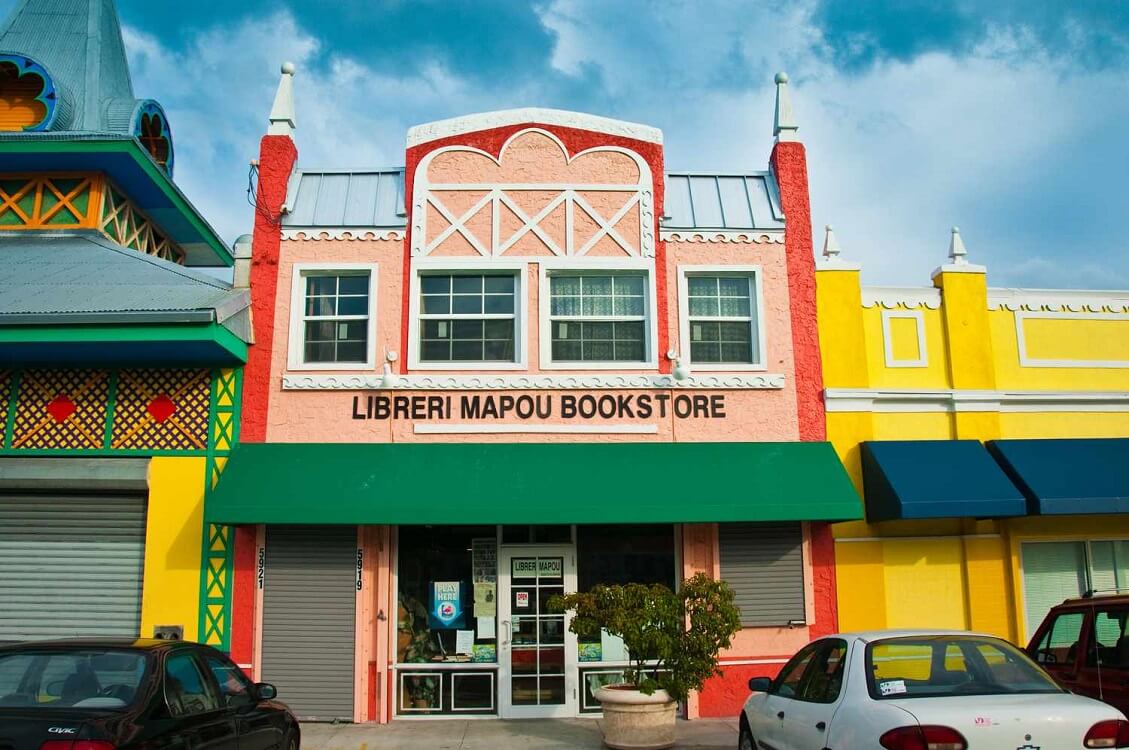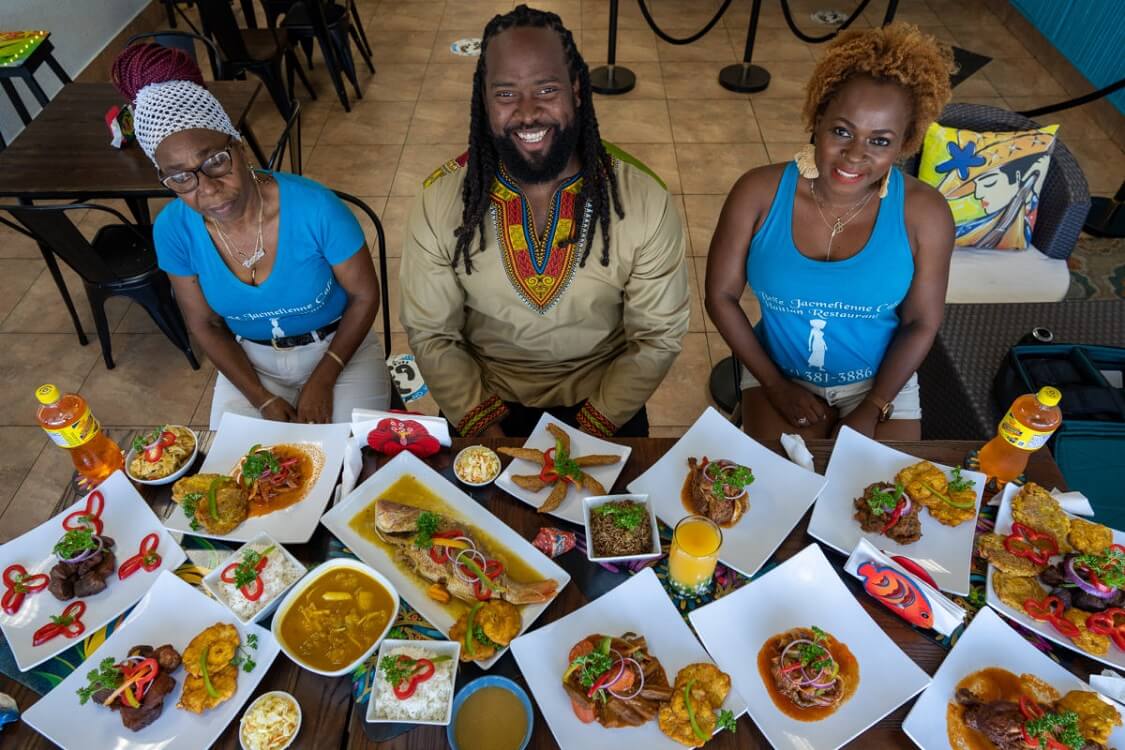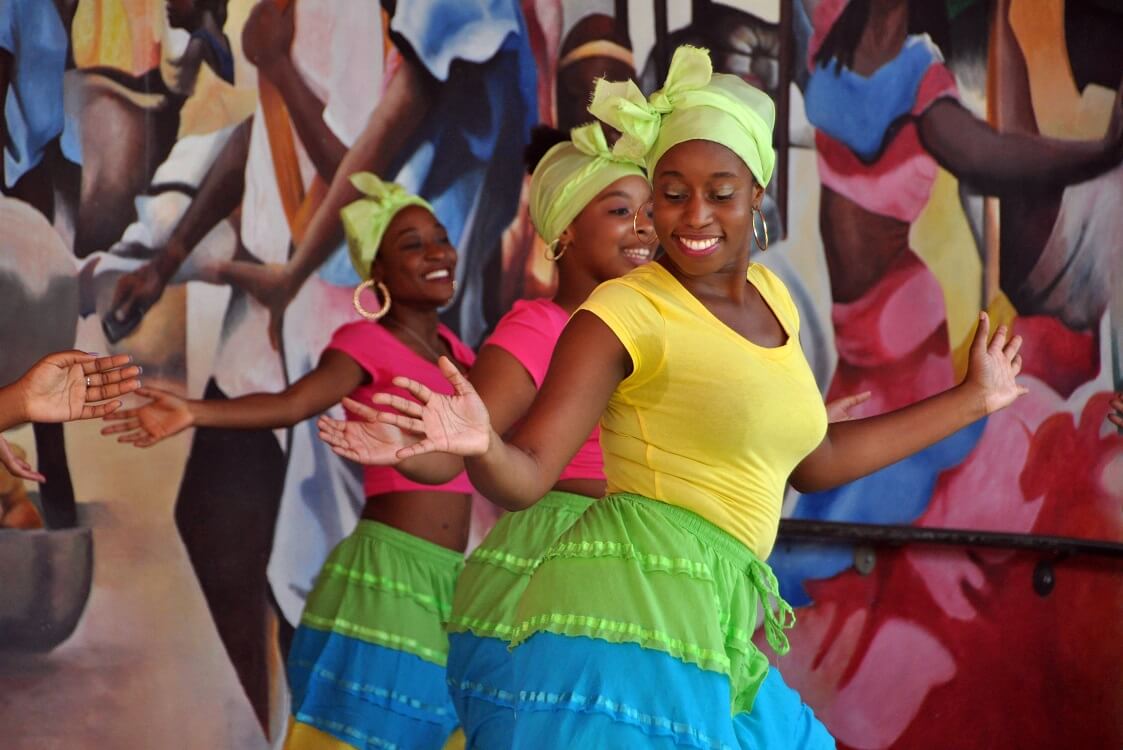Where is Haiti located?
Little Haiti is a vibrant neighborhood located in the heart of Miami, Florida. The area is known for its rich cultural heritage, which is reflected in its colorful murals, art galleries, and festivals. Little Haiti has a strong Haitian influence, and it is home to a large Haitian-American community.
One of the main attractions of Little Haiti is the Little Haiti Cultural Complex, which is a center for the arts and culture. It features a theater, a gallery, and a marketplace, where visitors can shop for Haitian crafts and products. The complex hosts a variety of events, including music performances, dance shows, and art exhibitions.
Another popular attraction in Little Haiti is the Caribbean Marketplace, which is a marketplace that sells a wide variety of Caribbean goods, including clothing, jewelry, and food. Visitors can sample traditional Haitian dishes like griot, fried plantains, and pikliz, a spicy Haitian condiment.

What is Haiti known for?
Little Haiti is also home to a number of restaurants, cafes, and bakeries that serve Haitian cuisine. Visitors can try the famous Haitian dish, poul ak NWA, which is chicken cooked in a rich, dark sauce made from mushrooms and onions. There are also plenty of vegetarian and vegan options available, such as legumes, a stew made with vegetables, and rice.
Throughout the year, Little Haiti hosts a variety of festivals and events that celebrate Haitian culture. One of the most popular events is the Haitian Cultural Festival, which takes place in May and features music, dance, and food. The Big Night in Little Haiti is another event that takes place on the third Friday of every month, where visitors can enjoy live music, art exhibits, and food vendors.
In summary, Little Haiti is a vibrant and culturally rich neighborhood in Miami that is well worth a visit. Visitors can immerse themselves in Haitian culture by sampling traditional foods, attending festivals and events, and exploring the art and music scene.

Top 10 interesting facts about Little Haiti
Here are 10 interesting facts about Little Haiti in Miami:
- Little Haiti was originally settled by Bahamian immigrants in the early 20th century but became a hub for Haitian immigrants in the 1980s.
- The neighborhood is located just north of downtown Miami and covers roughly 3 square miles.
- Little Haiti is home to a number of historic sites, including the Little Haiti Cultural Complex and the Caribbean Marketplace.
- The neighborhood has a vibrant arts scene, with a number of galleries, studios, and public art installations.
- Little Haiti is known for its delicious Haitian cuisine, including traditional dishes such as griot (fried pork) and tasso (fried beef).
- The annual Haitian Compas Festival, which celebrates Haitian music and culture, takes place in Little Haiti each May.
- Little Haiti is also home to a number of community organizations and nonprofits that work to support Haitian immigrants and their families.
- The neighborhood has faced challenges in recent years due to gentrification and rising housing costs, which have led to concerns about the displacement of long-time residents.
- Little Haiti has been designated by the City of Miami as a Special Area Plan, which aims to promote economic development and cultural preservation in the neighborhood.
- Despite these challenges, Little Haiti remains a vibrant and culturally rich neighborhood that is beloved by its residents and visitors alike.

Famous people from Little Haiti
Little Haiti has produced a number of notable individuals in various fields, including music, sports, and politics. Here are some famous people from Little Haiti:
- Wyclef Jean: Grammy Award-winning musician, producer, and actor, best known as a founding member of the hip-hop group The Fugees.
- Edwidge Danticat: Haitian-American author and MacArthur Fellow, known for her novels, memoirs, and short stories that explore the experiences of Haitian immigrants.
- Manno Charlemagne: Haitian singer, songwriter, and political activist, known for his socially conscious lyrics and his work to promote democracy in Haiti.
- J.P. Arencibia: Former Major League Baseball player who played for the Toronto Blue Jays, Texas Rangers, and Tampa Bay Rays.
- Serge Toussaint: Haitian-American visual artist and photographer, known for his portraits and documentary work that explores the Haitian diaspora.
- Jacques Deschamps: Haitian-American businessman and philanthropist, known for his work to promote economic development and education in Haiti.
- Anedie Azael: Model and beauty pageant winner, crowned Miss Haiti in 2011 and represented Haiti at the Miss Universe pageant.
- Fabrice Jaumont: Education researcher, author, and expert on bilingual education, known for his work promoting multilingualism in education.
- Harold St. Louis: Haitian-American poet and spoken word artist, known for his performances that explore themes of identity, culture, and social justice.
- Dr. Smith Joseph: Haitian-American physician and politician, served as the mayor of North Miami from 2013-2019 and was the first Haitian-American elected to the position.

| Name | Field | Birthplace | Notable Works/ Achievements |
|---|---|---|---|
| Wyclef Jean | Musician | Haiti | Grammy Award-winning musician, founding member of The Fugees |
| Edwidge Danticat | Author | Haiti | MacArthur Fellow, known for her novels and memoirs exploring Haitian life |
| Manno Charlemagne | Musician/Activist | Haiti | Socially conscious musician and political activist |
| J.P. Arencibia | Baseball Player | Miami, FL | Played for the Toronto Blue Jays, Texas Rangers, and Tampa Bay Rays |
| Serge Toussaint | Visual Artist/Photographer | Haiti/USA | Portrait and documentary work exploring the Haitian diaspora |
| Jacques Deschamps | Businessman/Philanthropist | Haiti/USA | Work to promote economic development and education in Haiti |
| Anedie Azael | Model/Pageant Winner | Haiti | Crowned Miss Haiti 2011, represented Haiti at Miss Universe |
| Fabrice Jaumont | Education Researcher/Author | France/USA | Work to promote multilingualism in education |
| Harold St. Louis | Poet/Spoken Word Artist | Haiti/USA | A performance exploring themes of identity, culture, and social justice |
| Dr. Smith Joseph | Physician/Politician | Haiti/USA | Served as the mayor of North Miami, the first Haitian-American elected to the position |
Things to do in Little Haiti
Here are a few things to do in Little Haiti:

- Visit the Little Haiti Cultural Complex – This complex features a variety of cultural events and performances, including music, dance, theater, and visual arts.
- Try Haitian cuisine – Little Haiti has a range of Haitian restaurants that offer traditional dishes such as griot (fried pork), diri ak djon djon (rice with black mushrooms), and accra (fried fritters).
- Shop for Haitian crafts – Little Haiti has a number of shops and boutiques that offer handcrafted items such as wood carvings, metalwork, and textiles.
- Attend the Big Night in Little Haiti – This monthly event features live music, dance performances, and food vendors, and is a great way to experience the vibrant culture of Little Haiti.
- Take a Haitian dance or drumming class – Little Haiti has a number of studios that offer classes in Haitian dance and drumming, allowing you to learn more about the rich cultural heritage of Haiti.
| Thing to Do | Type of Activity | Cost | Best Time to Visit | Recommended Duration |
|---|---|---|---|---|
| Little Haiti Cultural Complex | Cultural events and performances | Free or low cost | Year-round | 2-3 hours |
| Haitian cuisine | Food and dining | $$ | Year-round | 1-2 hours |
| Shopping for Haitian crafts | Shopping | $-$$$ | Year-round | 1-2 hours |
| Big Night in Little Haiti | Monthly event | Free | Monthly, usually on the third Friday | 2-3 hours |
| Haitian dance or drumming class | Dance and music lessons | $$ | Year-round | 1-2 hours per class |
Note: The cost of Haitian cuisine and shopping can vary depending on the specific restaurant or shop. The cost range provided is a general estimate.
Little Haiti Cultural Center
One of the must-visit destinations in Little Haiti is the Little Haiti Cultural Complex. This vibrant and colorful complex is home to several galleries, theaters, and performance spaces that showcase the cultural heritage of Haiti. Visitors can enjoy art exhibits, dance performances, and live music shows that feature traditional Haitian music such as kompa, rara, and twoubadou. The complex also has a library, classrooms, and a garden where visitors can relax and learn more about Haitian culture and history.
The Little Haiti Cultural Complex is an important hub for the Haitian community in Miami and offers visitors an immersive experience of the rich cultural heritage of Haiti. The complex hosts several cultural festivals throughout the year, including the Haitian Compas Festival, which attracts visitors from all over the world. It is also home to the Caribbean Marketplace, a vibrant outdoor market where visitors can shop for Haitian handicrafts, artwork, and souvenirs. Whether you are interested in the arts, or music, or simply want to learn more about Haitian culture, a visit to the Little Haiti Cultural Complex is a must-do activity in Little Haiti.

Haitian Cuisine
Another must-do activity in Little Haiti is to try the delicious and flavorful Haitian cuisine. Little Haiti is home to several restaurants and food stalls that offer traditional Haitian dishes such as griot (fried pork), tasso (fried beef), and legume (vegetable stew). Visitors can also sample Haitian snacks such as akra (fried cassava balls) and pate (savory pastries filled with meat or vegetables). For dessert, be sure to try Haitian specialties such as douce (coconut candy) and pen potato (sweet potato pudding).
Visitors can also experience the vibrant and lively atmosphere of Little Haiti’s food scene by attending one of the neighborhood’s food festivals, such as the annual Taste of Haiti festival. These events showcase the diversity and richness of Haitian cuisine and provide a fun and festive atmosphere for visitors to sample different dishes and enjoy live music and entertainment. Whether you are a food lover or simply want to explore the local culture, trying Haitian cuisine is a must-do activity in Little Haiti.

Haitian crafts
Shopping for Haitian crafts is another popular activity in Little Haiti. The Caribbean Marketplace, located within the Little Haiti Cultural Complex, is a vibrant and colorful outdoor market that sells a variety of Haitian handicrafts, including wood carvings, metalwork, pottery, and textiles. Visitors can browse through the stalls and shops and find unique souvenirs and gifts to take home. The market also hosts several cultural events and festivals throughout the year, providing visitors with an immersive experience of Haitian culture and traditions.
Aside from the Caribbean Marketplace, visitors can also explore the many art galleries and boutiques located throughout Little Haiti. These establishments showcase the work of local artists and designers and offer visitors the opportunity to purchase one-of-a-kind artworks and handicrafts. Some popular destinations for art lovers include the Little Haiti Cultural Center’s art gallery and the Yeelen Gallery, which specializes in contemporary art from Africa and the African diaspora. Whether you are looking for traditional Haitian crafts or contemporary artworks, shopping in Little Haiti is a must-do activity for visitors looking to experience the neighborhood’s unique cultural heritage.

The Big Night in Little Haiti
Attending the Big Night in Little Haiti is a fun and exciting way to experience the vibrant cultural scene in Little Haiti. This monthly event, which takes place on the third Friday of every month, features live music, dance performances, and cultural demonstrations that showcase the rich heritage of Haiti. Visitors can enjoy traditional Haitian music such as kompa and rara, watch dancers perform the traditional Haitian folk dance known as the Haitian quadrille, and learn more about Haitian history and culture through art exhibits and cultural presentations.
In addition to the cultural festivities, the Big Night in Little Haiti also features a variety of food vendors and crafts sellers, allowing visitors to sample traditional Haitian dishes and shop for unique handicrafts and souvenirs. The event provides a lively and festive atmosphere that celebrates the diversity and richness of the Haitian community in Little Haiti. Whether you are a fan of music, or dance, or simply want to explore the local culture, attending the Big Night in Little Haiti is a must-do activity for visitors to the neighborhood.

Haitian dance or drumming class
Little Haiti is known for its vibrant and lively music and dance scene, and taking a Haitian dance or drumming class is a great way to experience this unique aspect of the neighborhood’s culture. Visitors can attend classes at local dance studios and community centers, where they can learn traditional Haitian dances such as merengue, kompa, and the Haitian quadrille. Many classes also include live drumming, providing a thrilling and immersive experience of Haitian music and dance.
For those interested in learning to play Haitian drums, there are also several classes and workshops available in Little Haiti. Visitors can learn to play traditional Haitian rhythms such as the rara, vodou, and kompa, and experience the unique and complex rhythms that define Haitian music. Taking a dance or drumming class in Little Haiti is a fun and engaging way to learn about Haitian culture and connect with the local community. Whether you are a beginner or an experienced dancer or musician, there are plenty of opportunities to learn and explore in Little Haiti.

Restaurants in Little Haiti
Little Haiti is home to a vibrant culinary scene, with a variety of restaurants offering authentic Haitian cuisine as well as other Caribbean and Latin American dishes. Some popular restaurants in the neighborhood include Chef Creole Seafood & Catering, which serves up classic Haitian dishes such as griot (fried pork) and tasso (fried beef), as well as fresh seafood platters. Leela’s Restaurant is another local favorite, offering a fusion of Haitian and Indian flavors, with dishes such as goat curry and fried plantains.
For those looking for a casual bite to eat, local food trucks such as Piman Bouké and Lick Miami offer a range of Haitian street food options, including griot, pikliz (spicy pickled vegetables), and Accra (deep-fried dough balls). There are also several bakeries and cafes in the neighborhood, such as Kafe Cafe, which offers a selection of coffee drinks and baked goods.

Overall, Little Haiti’s restaurant scene is a great place to explore the unique flavors and ingredients of Haitian cuisine, as well as other Caribbean and Latin American dishes. Whether you’re looking for a sit-down meal or a quick snack on the go, there are plenty of options to choose from in this vibrant and culturally rich neighborhood.
Conclusion
In conclusion, Little Haiti is a vibrant and culturally rich neighborhood in Miami, with a deep connection to Haiti and its traditions. From its colorful street art and murals to its lively music and dance scene, Little Haiti offers visitors a unique and immersive experience of Haitian culture. Whether you’re exploring the local food scene, attending a cultural event, or simply strolling through the neighborhood’s streets and parks, Little Haiti is a must-visit destination for anyone interested in learning more about Haitian culture and connecting with the local community.

Little Haiti FAQ
Q: What is Little Haiti?
A: Little Haiti is a neighborhood in Miami, Florida, with a strong cultural and historical connection to Haiti and its traditions.
Q: Why is Little Haiti called Little Haiti?
A: The neighborhood is called Little Haiti because of its large population of Haitian immigrants and their descendants, who have made a significant impact on the area’s culture and community.
Q: What are some things to do in Little Haiti?
A: Some popular things to do in Little Haiti include visiting the Little Haiti Cultural Complex, trying Haitian cuisine at local restaurants, shopping for Haitian crafts and artwork, attending cultural events like the Big Night in Little Haiti, and taking a Haitian dance or drumming class.
Q: Is Little Haiti safe to visit?
A: While no neighborhood is completely immune to crime, Little Haiti is generally considered safe to visit. As with any urban area, it’s always a good idea to take basic precautions like being aware of your surroundings, avoiding carrying large amounts of cash, and not leaving valuables unattended.
Q: How do I get to Little Haiti?
A: Little Haiti is located in the northern part of Miami, roughly 4 miles north of downtown. You can reach the neighborhood by car or public transportation, with several bus lines running through the area and a Metrorail station located nearby.
Q: What is the history of Little Haiti?
A: Little Haiti has a rich history that dates back to the 1960s, when the first wave of Haitian immigrants began arriving in Miami. Over the years, the neighborhood has become a hub for Haitian culture and activism, with a strong sense of community and pride in its heritage.
Q: What is the Little Haiti Cultural Complex?
A: The Little Haiti Cultural Complex is a community arts and cultural center in Little Haiti, offering a range of programs and events focused on Haitian and Caribbean culture. The complex features a theater, art galleries, event spaces, and more, and hosts events like concerts, festivals, and educational programs.
Q: What is Haitian cuisine like?
A: Haitian cuisine is a delicious and unique blend of African, French, and Caribbean influences. Some popular Haitian dishes include griot (fried pork), diri kole ak pwa (rice and beans), and tasso (fried meat). Many restaurants in Little Haiti specialize in Haitian cuisine, offering visitors a chance to sample these tasty dishes.
Q: What is the Big Night in Little Haiti?
A: The Big Night in Little Haiti is a monthly cultural event featuring live music, dance performances, art displays, and more. The event is held on the third Friday of each month at the Little Haiti Cultural Complex, and is a great way to experience the vibrant and dynamic culture of Little Haiti.
Q: What are some other cultural attractions in Little Haiti?
A: In addition to the Little Haiti Cultural Complex, there are many other cultural attractions in Little Haiti. These include the Haitian Heritage Museum, which features exhibits on Haitian history and culture, and the Caribbean Marketplace, a marketplace selling handmade crafts and goods from Haiti and other Caribbean countries.
Last Updated on May 4, 2023 by Viktoria

Comments are closed